Taming Aquatic Vegetation
4/9/2020 9:11:30 AM
By Ryan Jones
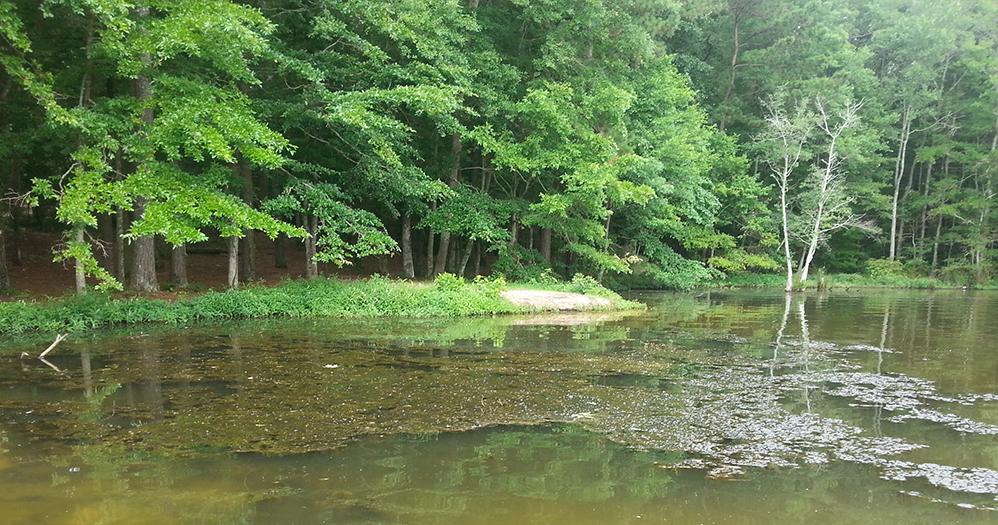
C.A. Schultz, a former fisheries biologist with Mississippi Department of Wildlife, Fisheries, and Parks (MDWFP), often said, “could be good, could be bad” when faced with a new situation. The same could be said of aquatic vegetation in Mississippi ponds. Too few plants deprive young fish of hiding places and adult fish of ambush points. Too many plants can reduce foraging efficiency for both juvenile and adult fish and impede an angler’s ability to fish. Controlled or tamed vegetation strikes a balance between promoting a healthy fish population and a lake full of weeds.
Many pond owners in Mississippi have problems with aquatic plants. What should you do when you have a vegetation problem on your lake? Identify the plant. It is critical to know what the problem plant is so that appropriate control measures can be used. Weeds can be controlled using a variety of methods, which are usually categorized as physical, mechanical, biological, and chemical. Some treatment measures can be effective on one type of plant and totally ineffective on another. For example, grass carp are good at controlling soft-stemmed plants like parrot feather and coontail but not suitable for controlling filamentous algae or hard-stemmed plants like alligator weed. It bears repeating, identifying the problem plant is extremely important before beginning plant control activities.
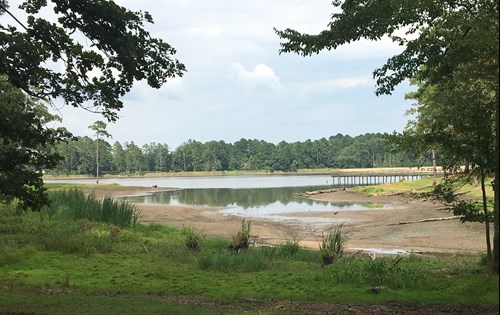
Winter drawdown
Physical manipulation, such as a winter drawdown, is one way to control unwanted plants. During the fall, water should be released to expose the pond bottom where the problem vegetation grows. The drawdown should be completed by November and continue through February. This practice air-dries the exist-ing plants and exposes the roots to freezing temperatures. Additionally, because aquatic plants need shallow water and sunlight to flourish, the shoreline can be deepened during the drawdown. Water depth should be at least 3 feet to reduce sunlight penetration to the bottom. Excess dirt removed along the shoreline can be used to create earthen piers.
A proper fertilization program can reduce aquatic vegetation problems. Fertilizing creates a green bloom of microscopic plants called phytoplankton, which shades the bottom from sunlight and prevents plant growth from starting. Import-ant note: Do not fertilize if the pond contains abundant aquatic plants.
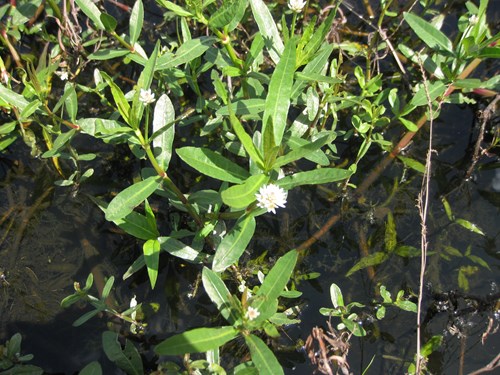
Alligatorweed
Simple mechanical controls, such as raking or removing the weeds by hand, can rid the pond of a few un-wanted plants. These methods work best when the plants are just beginning to appear in the pond and only cover a small area. Small mats of filamentous algae can be removed by seining, but algae will grow back and must be removed again. Mechanical methods are often used in conjunction with other ways to increase their effectiveness.
Biological control can be the most cost-effective management practice available. Landowners can stock grass carp to help control vegetation. Grass carp are inexpensive and provide long-term plant control. Again, proper weed identification is vital before stocking grass carp. These fish prefer tender, submerged vegetation, such as coontail and pondweed, and are not effective on coarse vegetation, such as lily pads and water primrose. Grass carp will not re-produce in a pond, but MDWFP recommends stocking sterile, triploid fish to prevent escaped carp from establishing wild populations in public waterways. Depending on the severity of the plant problem, MDWFP recommends stock-ing 5-10 grass carp per acre of water.
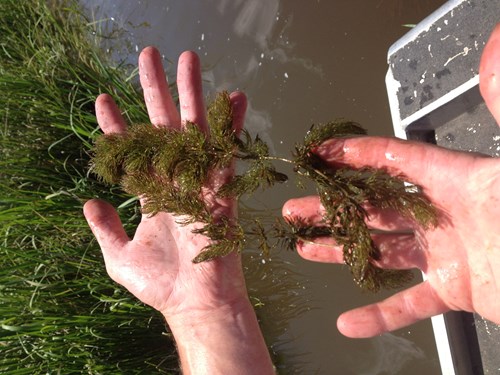
Coontail
Finally, chemical treatment is a common control method. It can be expensive but effective. Chemical herbicides can be liquid or granulated. Liquid herbicides are used on emergent (out of the water) vegetation and sprayed onto the plants. Granulated herbicides fall to the bottom, affecting the root system of the plant. Granulated herbicide can also dissolve in the water column and work as a contact herbicide underwater.
Again, before you buy any herbicide, always accurately identify the plant. Different herbicides target different plants. Always calculate the correct water vol-ume or surface area to be treated, and always read the product label. If the pond is infested with plants, partial treatments are necessary to prevent oxygen depletion, which can stress or kill fish. A good rule to follow is to treat only one-third of the pond at a time to prevent oxygen depletion. Also, a surfactant should be used with some chemicals. Aquatic plants usually have a waxy coating on their leaves that protects them from their environment. A surfactant breaks away the coating, allowing more chemicals to penetrate the leaves. Only use chemicals approved for aquatic use and always read the label before applying aquatic herbicides.
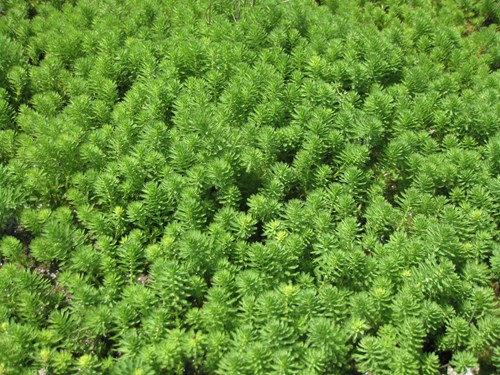
Parrot feather
Using multiple control techniques is often the most successful way to control vegetation problems. For example, thick vegetation mats can be treated with herbicides. If the plant grows back, it can be manually removed before it becomes a big problem. Also, multiple plant species could require different treatment techniques. A draw-down can inhibit submerged plant growth in shallow areas of the pond, but floating mats of vegetation will not be affected. In this case, use chemical, mechanical, or biological methods to accomplish the goal.
Not all aquatic vegetation can become a problem; preserving some native aquatic vegetation is good. Plants provide great fish habitat and also serve as food resources for other wildlife. They provide shelter for young of the year fish, food resources in the form of aquatic insects, and spawning sites for most fish species. MDWFP recommends maintaining 10-20% percent vegetation coverage in ponds to provide quality, productive habitat. A great management strategy is to maintain small areas of plants, essential-ly taming your aquatic vegetation.
If you have questions about aquatic plant identification and control, contact your local Mississippi State University (MSU) Extension Service office or the MDWFP Fisheries Bureau at (601) 432-2200. The websites for MDWFP (mdwfp.com) and the MSU Extension Service (msucares.com) provide good sources for aquatic plant control.
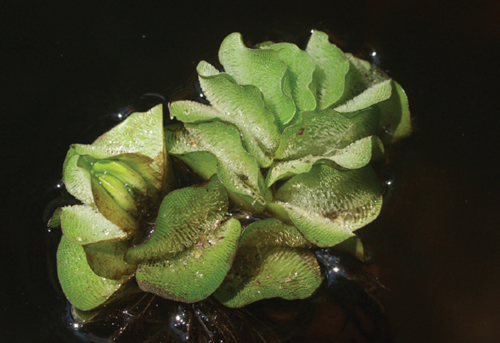
Giant salvinia / Photo by Mark A. Garland, hosted by the USDA-NRCS PLANTS Database
Tackling Giant Salvinia
A new threat to Mississippi’s public and private aquatic resources is giant salvinia (Salvinia molesta). This exotic invasive floating fern, originally from southern Brazil, can regenerate exponentially by doubling in biomass in just a few days. In ideal conditions for growth, dense mats are formed up to three feet thick. The mats shade sunlight, consume nutrients and prevent water mixing. Native vegetation stands are often eliminated and deoxygenized water results in unusable habitat for fish and other aquatic animals. Giant salvinia reproduces by vegetative budding, meaning one plant can create a mat of clones that can quickly cover an entire waterbody. Once established, eradication is challenging. The best management practice is prevention. Always clean, drain, and dry your watercraft and trailer when moving from one waterbody to another.
Currently in Mississippi, giant Salvinia exists in the Tennes-see-Tombigbee Waterway, Pascagoula River marsh, Lake Okhissa, Ross Barnett Reservoir, and some private ponds. Recent management in Ross Barnett Reservoir has consisted of aggressive herbicide treatments from airboats and helicopters, deployment of a system of containment booms, lake level drawdowns, recreational access closures and restrictions, numerous surveys to find new colonies, and prescribed fire to remove other vegetation which harbor the plant. These efforts are necessary for any chance of eradication from one of the most highly recreated waterbodies in the state.
Ryan Jones is a fisheries biologist for MDWFP.









